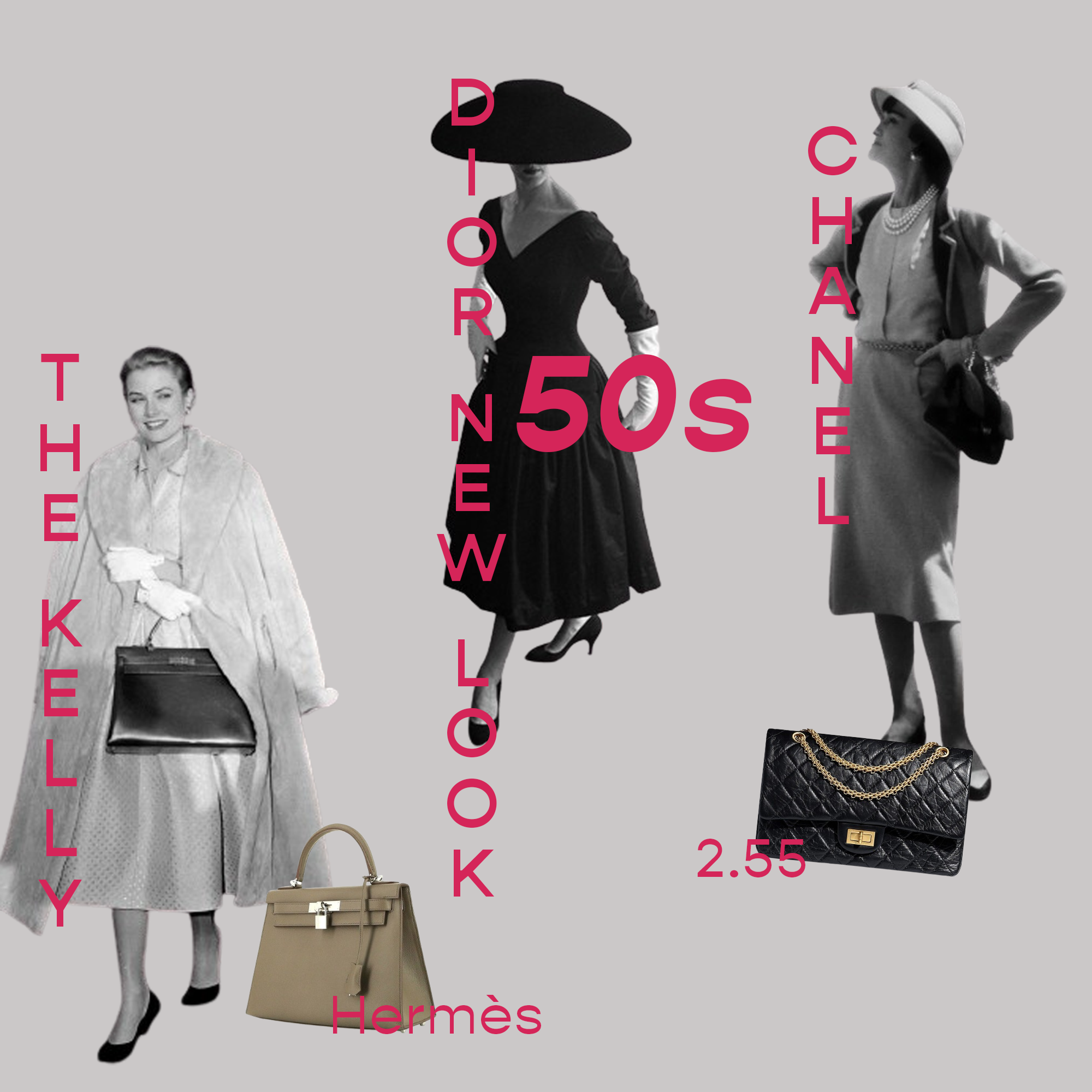A Woman and Her Handbag: a Love Story.
Published 12.09.24WRITTEN BY avivalyn
Handbags are a crucial element of women's fashion. Not only can they bring an outfit together, but they also carry all our worldly bits, bobs, gadgets, paraphernalia, and artefacts. Whether you believe the conspiracy that Big Handbag owes its success to the minuscule pockets seen on women’s pants or not, we have certainly become similar to Mary Poppins and her infamous bag.
The shapes and sizes of bags have fluctuated immensely throughout the years…
The 50s saw smaller, structured bags balance Dior’s New Look, which featured a nipped waist and full skirts. In 1956, Grace Kelly was seen wearing a Hermès bag, called Sac à Courroies at the time, which became known as the Hermès Kelly two decades later. Another iconic bag was born in the 50s, with Coco Chanel reinventing the bag by releasing the 2.55—the first bag with a shoulder strap, offering practicality.
Mini skirts, loose-fit shift dresses, and pantsuits. In the 1960s, women were experiencing newfound freedom within their fashions. Many turned away from handbags, opting for shift dresses with pockets to carry their things. However, Paco Rabanne released their chainmail bags, ready to glint and gleam on the dancefloor. The now-trending Bottega woven leather bags were also introduced in the 60s.
The influences of the 70s boho and hippy style brought trimmed, embroidered, suede, and crossbody bags. Karl Lagerfeld’s Chloé, the newly founded Mulberry, and the Spanish Loewe were the notable brands offering this handbag aesthetic. On the other hand, the glamorous Whiting and Davis mesh bag, popular in the late 70s, would have been seen swinging about in Studio 54.
The ostentatious aesthetics of the 1980s extended to handbags. Now more than ever, glimmering logos were seen emblazoned on the hardware of handbags. Hermès created the Birkin in honour of British-French actress, singer, and style icon Jane Birkin. Miuccia Prada’s first bag release, responding to a desire for practicality, was made out of a durable nylon material that was previously exclusively for the Italian army. This was the dawn of utilitarian fashion.
The Fendi Baguette was the It-bag of the 1990s. It was designed to rest underneath the arm, just like the French bread loaf. The iconic bag was seen in the fashion-forward show Sex and the City and on the arms of Naomi Campbell and Madonna. Prada’s backpack offered the one thing the Baguette did not: practicality.
John Galliano’s Dior Saddle bag is one of the most notable bags of the 2000s. It was created in an array of colours and patterns, from camo to baby pink. Balenciaga’s Motorcycle bag, which would not exist if it was not for Kate Moss’ endorsement, was another iconic noughties bag. Many of the popular bags swinging from the shoulders of 2000s style icons were big, slouchy, soft, and heavy.
The minimalist Celine Luggage Tote became a cult favourite in the 2010s. Alongside this, Mulberry released the Alexa, which was inspired by Alexa Chung’s style and her appreciation for menswear. The end of the decade saw the - certainly impractical - tiny bag trend. Jacquemus brought the micro bags on and we saw them resting on the fingertips of Lizzo, Rihanna, and the Kar-Jenners.
Now, we have come to the 2020s. Bags are pillowy, colourful, and practical, with keychains, ribbons, and figurines hanging from them - treating our bags like Jane Birkin did. They have become more of an extension of us than an extension of our outfit. We carry our lives around in our bags, and we decorate our bags with our favourite things - our accessories now have accessories. This lived-in look is the handbag trend of the decade.
Okay, now it is time for you to tie another ribbon on your bag and clean out all the random useless things that have accumulated in there!









